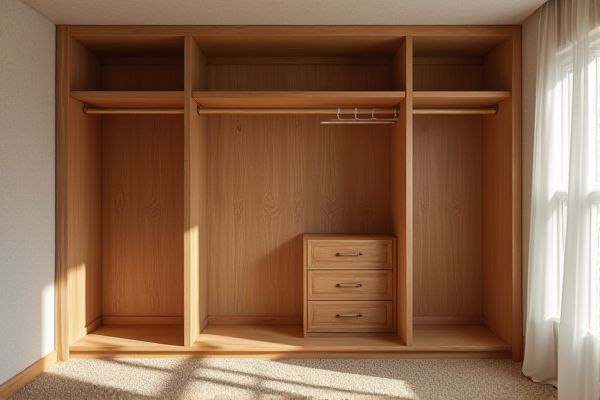
A cedar-lined closet offers natural protection against mold, mildew, and insects while providing a pleasant aroma, unlike a standard closet that lacks these benefits. Discover why choosing a cedar-lined option can enhance your storage experience and protect your belongings by reading the rest of this article.
Table of Comparison
| Feature | Cedar-Lined Closet | Standard Closet |
|---|---|---|
| Material | Natural cedar wood lining | Typically plywood, MDF, or laminate |
| Aroma | Distinctive cedar scent repels moths | No natural scent |
| Pest Resistance | Natural insect repellent properties | Requires external pest control |
| Humidity Control | Absorbs moisture, reduces mold risk | Limited moisture absorption |
| Durability | Long-lasting and resistant to decay | Varies by material and maintenance |
| Cost | Higher initial investment | Generally lower cost |
| Maintenance | Occasional sanding to refresh aroma | Minimal maintenance needed |
| Appearance | Natural wood aesthetic | Variety of finishes, less natural |
Introduction: Cedar-Lined Closet vs. Standard Closet
A cedar-lined closet offers natural resistance to moths and mildew, protecting your clothes while adding a pleasant aroma that standard closets lack. Unlike typical closets made from particle board or laminate, cedar absorbs moisture, helping to regulate humidity and prevent mold growth. Investing in a cedar-lined closet enhances the longevity and freshness of your wardrobe by leveraging its unique wood properties.
What Is a Cedar-Lined Closet?
A cedar-lined closet is a storage space finished with cedar wood panels or planks, known for its natural aromatic oils that repel moths, insects, and mold while preserving clothing quality. Unlike standard closets that use basic wood or laminate, cedar-lined closets provide humidity regulation and a pleasant fragrance, extending the lifespan of stored garments. This specialized lining helps prevent damage to delicate fabrics by maintaining an optimal microenvironment within the closet.
Features of a Standard Closet
Standard closets typically feature basic wooden or laminate shelves, hanging rods, and minimal ventilation, designed primarily for straightforward clothing storage. Unlike cedar-lined closets, they lack natural moth-repellent properties and aromatic wood benefits, which can lead to increased risk of fabric damage and musty odors. Your choice may depend on whether you prioritize affordability and simplicity over specialized protection and fragrance.
Benefits of Cedar-Lined Closets
Cedar-lined closets offer natural resistance to moisture, mold, and insects, protecting your clothing and belongings from damage. The aromatic wood provides a fresh scent that repels moths and other pests without harmful chemicals. Your wardrobe stays fresher longer while benefiting from cedar's natural insulating properties that help regulate humidity.
Advantages of Standard Closets
Standard closets offer versatile storage options with customizable shelving and hanging space to fit various needs and room sizes. They provide cost-effective solutions for organizing clothes, shoes, and accessories without the maintenance requirements of specialized materials like cedar. Their neutral finishes easily blend with different interior designs, making them adaptable to any home decor style.
Cost Comparison: Cedar-Lined vs. Standard Closet
Cedar-lined closets typically cost between $1,000 and $3,000 more than standard closets due to the premium wood and specialized installation required. Standard closets, often made with MDF or laminate, range from $500 to $1,500 depending on size and materials. The higher upfront investment in a cedar-lined closet is offset by its natural pest resistance and moisture control, reducing costs related to garment protection over time.
Maintenance Requirements
Cedar-lined closets require less maintenance than standard closets due to their natural resistance to moisture, mold, and insect damage. The aromatic oils in cedar wood act as a natural repellent against moths and mildew, reducing the need for chemical treatments and frequent cleaning. Choosing a cedar-lined closet can help preserve your clothing and belongings with minimal upkeep, making it a practical investment for long-term maintenance efficiency.
Impact on Clothing Preservation
Cedar-lined closets provide natural protection against moths, mold, and mildew, significantly prolonging the life of your clothing compared to standard closets. The aromatic oils released by cedar help repel insects and absorb moisture, preventing fabric damage and odors. Investing in a cedar-lined closet enhances clothing preservation by maintaining a dry, insect-free environment that standard closets cannot offer.
Aesthetic Appeal and Customization
A cedar-lined closet offers a warm, natural aesthetic with rich wood tones that enhance your room's elegance compared to the typical flat surfaces of standard closets. Customization options for cedar closets include adjustable shelves, built-in hooks, and partitions that maintain functionality while showcasing the wood's grain, appealing to both design and practical needs. Your choice of a cedar-lined closet not only elevates visual appeal but also gives you tailored storage solutions unmatched by conventional designs.
Which Closet Type Is Right for You?
Cedar-lined closets offer natural resistance to moisture, mold, and pests, making them ideal for preserving delicate clothing and preventing odors. Standard closets, typically constructed from basic wood or laminate, provide a cost-effective and versatile storage solution suitable for most everyday needs. Choosing between the two depends on your budget, the value of stored items, and your preference for long-term garment protection versus standard storage functionality.
 homyna.com
homyna.com